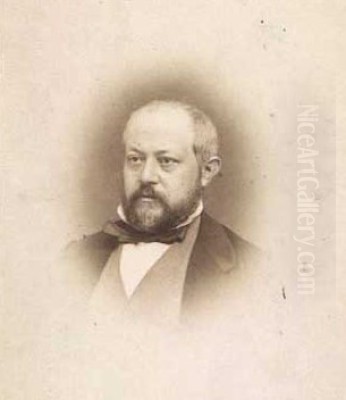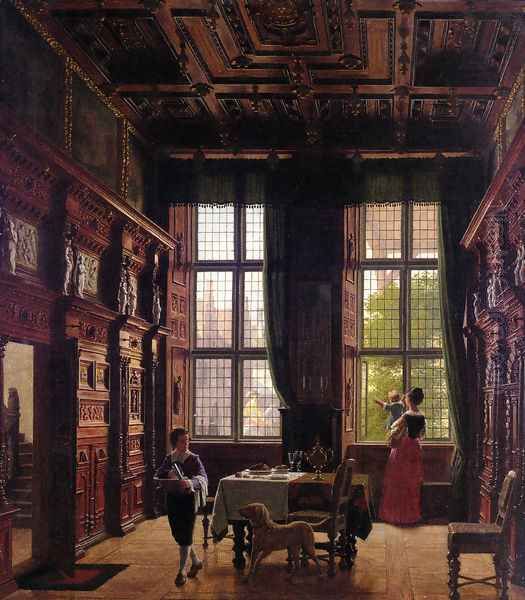
Heinrich Hansen stands as a pivotal figure in 19th-century Danish art, celebrated primarily as the nation's first prominent specialist in architectural painting. Born on November 23, 1821, in Haderslev, South Jutland, and passing away on July 10, 1890, in Frederiksberg, Hansen's career bridged the late Danish Golden Age and the emerging currents of Historicism. His meticulous and atmospheric depictions of historical interiors and exteriors not only captured the grandeur of the past but also played a role in preserving the visual memory of Denmark's architectural heritage. Beyond painting, his talents extended to decorative arts and influential restoration projects, cementing his legacy as a versatile and respected artist and cultural contributor. He also held the honorary title of State Councillor (Etatsråd), reflecting his standing in Danish society.
Early Life and Academic Foundations
Heinrich Hansen's artistic journey began not with grand architecture, but with the intricate world of decorative painting. In 1842, he moved to Copenhagen, the vibrant heart of Danish cultural life, to enroll at the prestigious Royal Danish Academy of Fine Arts. The Academy, still resonating with the influence of Christoffer Wilhelm Eckersberg, the father of the Danish Golden Age, provided a rigorous foundation in drawing, perspective, and composition. Hansen initially focused his studies on decorative arts, a field demanding precision and a keen sense of design.
Even before formally completing his studies, Hansen's talent was recognized. He was engaged to assist in the decoration of the Thorvaldsen Museum, a significant neoclassical building designed by Michael Gottlieb Bindesbøll to house the works of the renowned sculptor Bertel Thorvaldsen. This early exposure to a major architectural and decorative project undoubtedly shaped his developing interests. His skill was further affirmed in 1846 when he received a silver medal from the Academy for his proficiency in live model painting, demonstrating a solid grounding in figurative art alongside his decorative inclinations.
A Pioneer in Architectural Painting

While decorative work marked his beginnings, Hansen soon found his true calling in architectural painting. He is widely regarded as the first Danish artist to dedicate his career almost exclusively to this genre. At the time, while artists like Christen Købke or Martinus Rørbye occasionally depicted buildings within their cityscapes or travel scenes, Hansen focused intently on architecture itself, particularly the rich details of historical interiors. This specialization set him apart and allowed him to develop an unparalleled expertise in capturing the essence of built spaces.
His transition was supported by further study and travel. In 1847, he was awarded the prestigious Reiersen scholarship (Det Reiersenske Legat), which enabled him to travel abroad, primarily to Germany. This journey was crucial, exposing him to different architectural styles and likely reinforcing his commitment to the genre. Seeing the magnificent churches, castles, and town halls of Germany provided ample inspiration and subject matter, broadening his artistic horizons beyond Denmark. This period of study and observation laid the groundwork for a career dedicated to the intricate portrayal of architectural forms.
Capturing Historical Grandeur: Major Works and Subjects
Heinrich Hansen's oeuvre is dominated by detailed and atmospheric paintings of significant historical buildings, both in Denmark and abroad. He possessed a remarkable ability to render complex perspectives, intricate ornamentation, and the interplay of light and shadow within vast interiors. His works often evoke a sense of historical reverence and romantic nostalgia, transporting the viewer into the spaces he depicted.
Among his most celebrated subjects was Frederiksborg Castle in Hillerød, a masterpiece of Danish Renaissance architecture. Hansen painted numerous views of its opulent halls and chambers, capturing the grandeur associated with King Christian IV. His paintings of Frederiksborg became particularly poignant after a devastating fire ravaged much of the castle in 1859. Hansen's pre-fire depictions served as valuable historical records, and he was later involved in documenting and potentially guiding aspects of the meticulous restoration efforts led by architect Ferdinand Meldahl.
Rosenborg Castle in Copenhagen, another royal residence rich with history, also featured prominently in his work. He painted its well-preserved interiors, such as the Audience Chamber, with characteristic attention to detail, showcasing the tapestries, stucco work, and period furnishings. Similarly, Kronborg Castle in Helsingør, famed as the setting for Shakespeare's Hamlet, provided dramatic subject matter.
His travels yielded significant works as well. Paintings like "Interior, Lübeck" demonstrate his interest in the Brick Gothic architecture of Hanseatic cities. He is also known to have painted church interiors in Belgium, such as Antwerp Cathedral, showcasing his ability to capture the soaring verticality and complex light of Gothic structures. A notable early commission involved decorative work in Christian IV's Chapel at Roskilde Cathedral between 1844 and 1845, a project where he reportedly collaborated with the prominent history and genre painter Wilhelm Marstrand.
Artistic Style: Precision, Atmosphere, and Historicism
Heinrich Hansen's style is characterized by meticulous realism, a profound understanding of perspective, and a sensitivity to the effects of light. He worked primarily in oil paint, building up layers to achieve depth and richness in texture and colour. His architectural renderings are precise, almost documentary in their detail, yet they often possess a romantic atmosphere, emphasizing the historical weight and aesthetic beauty of the spaces.
While grounded in the observational tradition of the Danish Golden Age, Hansen's work aligns closely with the broader European movement of Historicism prevalent in the mid-to-late 19th century. Historicism involved a revival of and fascination with historical styles, and Hansen's focus on Renaissance, Baroque, and Gothic interiors perfectly captured this spirit. He wasn't merely recording buildings; he was celebrating their historical significance and architectural artistry. His paintings often include small figures, sometimes in period dress, which serve to animate the spaces and provide a sense of scale, but the architecture itself remains the undisputed protagonist.
His handling of light is particularly noteworthy. Whether depicting sunlight streaming through a high cathedral window or the softer, diffused light within a castle chamber, Hansen masterfully used light and shadow to define form, create depth, and evoke mood. Unlike the later Impressionists, his goal was not to capture a fleeting moment of light, but rather to render the enduring character of the space as revealed by its illumination. His contemporaries included landscape painters like Peter Christian Skovgaard, with whom he travelled, and J.Th. Lundbye, whose romantic sensibility towards the Danish landscape might find a parallel in Hansen's reverence for its historical architecture.
Contributions Beyond the Canvas: Decorative Arts and Restoration
Heinrich Hansen's artistic talents were not confined to easel painting. His early training in decorative arts continued to inform his career, and he undertook significant work in applied arts and design. One notable example is his design for a Rococo-style dinner service in 1872, demonstrating his versatility across different artistic disciplines and historical styles. He is also known to have designed furniture and silverware, contributing to the integrated approach to art and design characteristic of the period.
Furthermore, Hansen played an active role in the preservation and restoration of key Danish landmarks. His intimate knowledge of historical architecture, gained through years of careful study and painting, made him a valuable contributor to major restoration projects. His involvement with the restoration of Frederiksborg Castle after the 1859 fire was significant, likely involving documentation and consultation on the recreation of historical interiors. He was also involved in restoration efforts at Rosenborg Castle and Kronborg Castle. This practical engagement with architectural heritage underscores his deep commitment to preserving the past, both on canvas and in stone.
His ability to bridge the gap between fine art, decorative art, and architectural preservation highlights a holistic approach to cultural heritage. He understood that the beauty and significance of historical buildings lay not only in their structure but also in their interior decoration and furnishings, an understanding reflected in both his paintings and his applied arts work.
Collaborations, Influence, and the Artistic Milieu
Throughout his career, Heinrich Hansen interacted with many leading figures in the Danish art world. His early collaboration with Wilhelm Marstrand on the Roskilde Cathedral project connected him with one of the most versatile and respected painters of the era. He also maintained a close working relationship with the painter Carl Frederik Aagaard, who was known for both decorative work and landscapes. They collaborated on decorative paintings, and Hansen's influence, along with that of landscape painters like P.C. Skovgaard, is noted in Aagaard's development.
Hansen's work can be situated within a broader European context of architectural painting. While he developed a distinctly Danish focus, his detailed realism and historical subject matter resonate with the work of artists in other countries, such as the precise cityscapes of Eduard Gaertner in Germany or the earlier veduta painters of Venice like Canaletto and Francesco Guardi, though Hansen's focus was more often on interiors. His travels and the dissemination of his works through exhibitions and reproductions ensured his reputation extended beyond Denmark, influencing perceptions of Scandinavian historical architecture.
Within Denmark, he occupied a unique niche. While Constantin Hansen, another major Golden Age figure, also produced significant architectural studies and paintings (notably of Greek temples), Heinrich Hansen made the genre his primary focus. His dedication provided a benchmark for architectural representation and likely inspired younger artists interested in historical subjects. His meticulous approach stood in contrast to the emerging trends of Realism and later Impressionism, yet his work retained popularity due to its technical brilliance and evocative power.
Later Years and Enduring Legacy
In his later career, Heinrich Hansen continued to paint and remained an esteemed member of the Danish art establishment. He held the title of Professor, likely associated with the Royal Danish Academy of Fine Arts, acknowledging his mastery and contributions to the field. His status was further recognized by the honorary title of State Councillor (Etatsråd).
A testament to his and his wife Margrethe's commitment to supporting future generations of artists was the establishment of the "State Councillor Hansen and Wife Margrethe's Silver Wedding Anniversary Scholarship" (Etatsraad Hansen og Hustru Margrethe f. Mathiasens Sølvbryllupslegat). This act of philanthropy ensured their legacy would continue to foster artistic talent in Denmark.
His artistic lineage was also carried on directly through his son, Adolf Heinrich Hansen (1859-1911), who followed in his father's footsteps to become an architectural painter himself, often working in a similar detailed style.
Heinrich Hansen passed away in Frederiksberg, a municipality of Copenhagen, in 1890. He left behind a significant body of work that not only documents Denmark's architectural treasures but also celebrates their historical and aesthetic significance. He successfully carved out a specialized niche within Danish art, elevating architectural painting to a respected genre. His works remain highly valued for their technical skill, historical accuracy, and atmospheric beauty, securing his place as a key figure in 19th-century Danish art history. His paintings continue to offer invaluable insights into the appearance and ambiance of historical interiors, many of which have since been altered or lost.
Conclusion: A Lasting Vision of Architecture
Heinrich Hansen's contribution to Danish art lies in his dedicated and masterful portrayal of architecture. As a pioneer specializing in this genre, he brought a new level of focus and technical refinement to the depiction of historical buildings. His paintings of Frederiksborg, Rosenborg, Kronborg, and sites visited on his travels are more than mere representations; they are carefully constructed visions imbued with historical reverence and romantic sensibility. Through his meticulous brushwork and keen eye for detail and light, he captured the enduring spirit of these spaces. His parallel work in decorative arts and architectural restoration further highlights his deep engagement with cultural heritage. Remembered as a skilled painter, a respected professor, and an influential State Councillor, Heinrich Hansen's legacy endures in his beautiful canvases and his lasting impact on the appreciation of Denmark's architectural past.